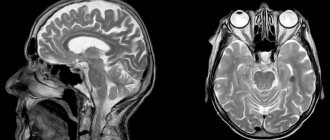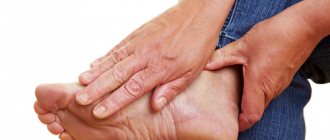Every woman’s body is full of surprises, and the changes that occur during the menstrual cycle make their own adjustments and affect how she feels. For some women, critical days pass calmly and are only occasionally disturbed by unpleasant symptoms, while for others, strong emotional swings, headaches, nagging painful sensations in the lower abdomen, breast tenderness, etc. are possible. Fainting during menstruation is not so common, but it does occur. in medical practice. The occurrence of fainting on menstruation days is very alarming to a woman, and in this regard, quite natural questions arise: how physiological is this condition and how can it be dealt with?
What is fainting and its types
Fainting is a brief loss of consciousness caused by a lack of blood flow to the brain. This condition is a mild form of acute vascular insufficiency. About 50% of all cases are vasovagal syncope, the simplest type. Simply put, this is a one-time loss of consciousness. In addition to it, the following types are distinguished:
- hypoglycemic;
- intoxication;
- hypovolemic;
- maladaptive;
- emotiogenic;
- hypoxic;
- cardiogenic;
- neurogenic;
- medicinal;
- somatogenic;
- anemic;
- discirculatory;
- hyperbaric;
- extreme.
Each of these species has its own characteristics and developmental pathogenesis.
How is the diagnosis carried out?
The first thing you need to do:
- blood analysis;
- sugar indicator;
- ECG;
- chest x-ray.
Diagnosis includes a blood test.
When examining a woman, the doctor may refer her for additional diagnostics. The most common methods for diagnosing fainting include the following studies:
- electrocardiography;
- Holter monitoring;
- electrophysiological study;
- echography and catheterization;
- electroencephalography;
- cerebral angiography;
- head scan;
- determination of glucose tolerance.
Causes of fainting
Fainting during menstruation most often does not have a pathological etiology and is associated only with temporary processes in the body. The main provocateur of fainting on critical days is low blood pressure. This happens if the female body cannot adapt to blood loss in a timely manner, and the heart muscle cannot cope with the increasing load at reduced pressure. Insufficient blood supply to body cells leads to oxygen starvation. This entails the appearance of corresponding symptoms.
Also during menstruation there are several other provoking factors that can lead to short-term loss of consciousness:
- the presence of severe pain;
- a state of frequent stress and depression;
- decreased hemoglobin in blood tests;
- a sharp decrease in blood pressure (hypotension);
- physical strain.
The pathological causes of fainting on menstruation days are as follows:
- lowering sugar levels;
- increased carbon dioxide levels in the blood;
- decrease in circulating blood volume (large blood loss);
- dehydration due to diarrhea, heavy sweating, frequent urination, etc.
Severe fright can also cause fainting.
Another provoking factor is algomenorrhea
The main symptom of algomenorrhea is pain in the lower abdomen, which occurs mainly on the first day of critical days and subsides on the second or third day. According to statistics, fainting in this condition occurs in 16% of cases with acute cramping pain caused by contractions of the uterus.
Algomenorrhea has 3 degrees of manifestation:
- light form
- medium shape;
- severe form.
In mild cases, moderate pain usually does not cause fainting. Fainting is possible only in severe cases and in rare cases in moderate cases. A similar phenomenon is associated with very intense pain, complemented by general weakness, fever, headache, vomiting, etc. In this state, the woman’s body includes a reflexive defense against reality, which is difficult to survive, and as a result, a state of fainting occurs.
The occurrence of fainting in adolescents
The onset of menstruation in teenage girls is a difficult turning point in life. At this time, in addition to emotional “explosions,” a global restructuring of the hormonal system occurs. During puberty, the physiological functioning of the gonads and the formation of the menstrual cycle usually begin at 12–13 years of age and end at 16–18 years of age.
Sex hormones affect all processes in the body, including the state of the central and autonomic nervous systems. Their instability, as well as physical and mental stress associated with studies and other activities, causes dizziness and fainting. Low blood pressure, large blood loss, low hemoglobin - all this can also provoke pre-fainting or fainting in a teenage girl.
Menopause: a common cause of fainting in women
Sooner or later in the life of every woman there comes an unpleasant period - menopause. This time is accompanied by symptoms that are quite difficult not to notice. Initial signs may include weight gain, increased heart rate and irregular periods.
The menopausal period is characterized by hot flashes that have a certain clinical severity, namely:
- a sharp feeling of heat in the upper half of the body, which can last about an hour, causing insomnia, dizziness and fainting;
- trembling and tingling in the arms or legs;
- paresthesia, or goosebumps;
- increased fatigue, irritability, depression;
- increase or decrease in blood pressure;
- dizziness with tinnitus and nausea;
- feeling of lack of air and shortness of breath;
- increased body sweating;
- headache, which can take on the character of a migraine;
- pain in the lower abdomen, back, joints, etc.;
- frequent urge to urinate and defecate.
Such signs, and especially in combination, can cause a woman to faint. This most often happens as a result of dizziness, low blood pressure and decreased hemoglobin. The main thing here is to arm yourself in time and be prepared for this period.
Syncope (from the Greek syncope - break, pause) is a sudden short-term transient loss of consciousness (LTC), resulting from general hypoperfusion of the brain, accompanied by loss of postural tone, often leading to a fall.
The term "syncope" roughly corresponds to the term "syncope", but is applicable primarily to vasovagal syncope. There are traumatic (due to TBI) and non-traumatic TPS. The relevance of this topic is growing and is interdisciplinary in nature, while there are not so many scientific studies and publications on syncope.
Interdisciplinary nature of syncope
During life, syncope (SS) occurs at least once in 35–50% of people. There are two peaks for the development of SS: at the age of 10–35 years and after 65 years. SS account for 1–3% of all emergency room visits and approximately 6% of all PICU admissions. In the general population, reflex fainting clearly dominates - up to 2/3 of all SS. A high probability of recurrence of vasovagal syncope has been established, varying in the range of 25–35% of cases per year.
CVs are a risk factor for sudden cardiac death and traumatic injuries for both the patient and others (syncope in drivers, people working in harmful and dangerous working conditions, etc.). The main threat is not loss of consciousness as such, but the underlying mechanisms of fatal disturbances in heart rhythm and conduction, which directly relates to emergency cardiology, functional diagnostics and invasive arrhythmology.
Currently, syncope is generally considered from the perspective set out in the new clinical Guidelines for the diagnosis and treatment of syncope, published in 2021 by the European Society of Cardiology (ESC). The latest edition focuses on improving the effectiveness of diagnostic and treatment measures, as well as assessing prognosis, reducing the risk of relapse and life-threatening consequences of CVD. It is proposed to consider syncope not only as a cardiac problem, but also as a phenomenon that doctors of different specialties have to deal with. It is also recommended to base diagnostic decisions on the results of long-term observation of the patient.
A new approach is the created electronic version of practical instructions, algorithms for diagnosing and treating TPS, available on the EOC website (www.escardio.org). The Ministry of Health of Belarus approved the Instruction on the procedure for providing specialized medical care to patients suffering from paroxysmal conditions (Order of the Ministry of Health of the Republic of Belarus dated February 27, 2014 No. 189), and published an educational manual “Syncopal conditions in the practice of a therapist” (Minsk, BSMU, 2013).
Classification of syncope
Reflex syncope
- Vasovagal:
- orthostatic VVS: in a standing position, less often in a sitting position;
- emotional stress: fear, pain (somatic or visceral), performing instrumental interventions, fear of blood.
- Situational:
- urination;
— stimulation of the gastrointestinal tract (swallowing, defecation);
- cough, sneezing;
- post-load;
- others (for example, laughter, playing wind instruments).
- Carotid sinus syndrome.
- Non-classical forms: without prodrome, and/or without obvious triggers, and/or atypical manifestations.
Syncope due to orthostatic hypotension (OH)
It must be remembered that hypotension can increase with fluid retention in the venous system during physical activity (stress), after eating (postprandial) and after a long stay in a lying position (detraining).
- Drug-induced OH (most common cause):
- when taking vasodilators, diuretics, phenothiazines, antidepressants.
- Decrease in circulating blood volume:
- bleeding, diarrhea, vomiting, etc.
- Primary autonomic dysfunction (neurogenic OH):
- idiopathic autonomic dysfunction, multiple system atrophy, Parkinson's disease, dementia with Lewy bodies.
- Secondary autonomic dysfunction (neurogenic OH):
- diabetes mellitus, amyloidosis, spinal cord damage, autoimmune autonomic neuropathy, paraneoplastic autonomic neuropathy, renal failure.
Cardiac syncope
Rhythm disturbances as the primary cause:
- bradycardia:
— sinus node dysfunction (including tachy-brady syndrome),
- violation of atrioventricular conduction;
- tachyarrhythmias:
- supraventricular,
- ventricular.
Structural heart disease: aortic stenosis, acute myocardial infarction/ischemia, hypertrophic cardiomyopathy, intracardiac neoplasms (myxoma cardiac, other tumors), pericardial disease/cardiac tamponade, congenital anomalies of the coronary arteries, prosthetic heart valve dysfunction.
Cardiopulmonary pathology and vascular pathology: thromboembolism of the pulmonary artery and its branches, acute aortic dissection, pulmonary hypertension.
Diagnosis of syncope
If TPS is suspected, it is necessary to conduct an initial examination, including a thorough history taking, examination, and ECG registration; general clinical blood and urine tests; biochemical blood test, troponin test for suspected syncope associated with myocardial ischemia, or D-dimer for suspected PE. A study of blood oxygen saturation and blood gas analysis are necessary if hypoxia is suspected.
Additional testing: Immediate ECG monitoring if arrhythmic syncope is suspected. Echocardiography in the presence of known cardiac pathology, or suspected structural cardiac disease, or syncope secondary to cardiovascular disease. According to indications of ultrasound of internal organs, endocrinological status. The initial examination allows us to identify the cause of fainting in 23% of patients, additional instrumental studies - in 27%.
Does the patient require hospitalization?
50% of patients admitted to emergency departments with SS are hospitalized. Composite assessment of outcomes indicates that in the next 7-30 days after syncope, a fatal outcome is recorded in only 0.8% of patients, and in 6.9% non-fatal serious events are detected. At the same time, another 3.6% experienced unfavorable outcomes after admission.
The main purpose of hospitalization is to prevent fatal outcomes and find the causes of syncope.
The patient management strategy consists of several stages: exclusion of urgent life-threatening pathology (cardiovascular, metabolic, trauma, infections, intoxication); diagnosis of cardiogenic syncope; diagnostic techniques for identifying reflex syncope.
Clinical picture and diagnosis
Three successive periods can be distinguished in the SS. The first - presyncope (lipothymia, presyncope) - is manifested by a feeling of weakness, blurred vision, tinnitus; lasts up to several minutes; Clinical signs include cold sweat and pale skin. The second—fainting itself—is characterized by a complete loss of consciousness, the pulse weakens or disappears, and systolic blood pressure drops to 55–60 mm Hg. Art.; Diffuse muscle weakness with decreased muscle tone and falling are also characteristic. At the moment of fainting, the patient lies motionless, the skeletal muscles are relaxed. The duration of this state is 25–30 s, less often 4–5 minutes; usually accompanied by myoclonic convulsions associated with hypoxia.
The third period is post-syncope. Restoration of consciousness and orientation occurs quickly. However, for an hour after fainting, weakness, dizziness, dry mouth, and anxiety may persist. An attempt to move to a vertical position can lead to repeated fainting.
Complete assessment program for patients with syncope
1. History (family, heart disease, lung disease, metabolic disorders, medication use, information about injuries).
2. Data on previous syncope, examination results.
3. Clarification of the nature of the actions that led to fainting (standing, walking, turning the neck, physical stress, urination, defecation, coughing, swallowing).
4. Clarification of previous events.
5. Determination of features of syncope:
- presence, manifestations and duration of presyncope;
- establishing the position in which the syncope occurred (standing, lying, sitting);
- symptoms during fainting (color and moisture of the skin, frequency and nature of breathing and pulse, convulsive syndrome);
- duration of fainting;
- presence, manifestations and duration of post-syncope.
6. Physical examination with an emphasis on identifying cardiovascular diseases (heart size, cardiac and vascular murmurs, blood pressure, pulse frequency and regularity, differences in pulse filling on both sides in the radial and carotid arteries, signs of heart failure, etc.).
7. Orthostatic test (orthostatic test and/or tilt table test), when fainting is associated with standing up or there is a suspicion of a reflex mechanism of fainting.
8. Test with massage of the carotid sinus in patients over 40 years old.
9. ECG analysis (if possible, during the period (immediately after) fainting, assessment of previous ECGs).
10. Assessment of neurological status with additional research methods (EEG, CT (MRI) of the brain, fundus examination).
11. If cardiogenic syncope is suspected, additional studies are carried out: daily ECG monitoring, echocardiography, electrocardiographic exercise tests, transesophageal pacing, electrophysiological study of the heart according to a special program in specialized departments.
12. Psychological testing for the purpose of diagnosing anxiety, depressive states and identifying the lability of psychological reactions.
Along with Holter 24-hour monitoring, an implantable loop recorder, external devices for ECG recording with the possibility of wireless signal transmission (in real time), smartphone applications, video recording with EEG monitoring (differential diagnosis with an epileptic seizure), electrophysiological study (not used more often) are used. than in 3% of cases).
General principles of treatment
The approach to the treatment of SS is based on risk stratification and, if possible, determining the mechanisms of development of syncope. Comorbid conditions must be taken into account, especially in elderly patients. Polypharmacy, the prescription of cardiovascular, psychotropic (neuroleptics and antidepressants) and dopaminergic drugs also increases the risk of developing syncope and falls. On the contrary, discontinuation or reduction of antihypertensive therapy reduces these risks. The decision to prescribe drugs with negative dromotropic and chronotropic effects should be carefully considered in elderly patients with syncope and a history of falls. Focal neurological events may occur due to hypotension and syncope, even in patients without significant carotid stenosis (so-called hypotension-associated TIAs).
Although the incidence of such events is only 6% among patients with recurrent syncope, their identification is important because misdiagnosis may lead to further reduction of blood pressure with antihypertensive drugs (for example, if focal symptoms are incorrectly correlated with vascular pathology rather than with hypotension), increasing the risk of developing CV and neurological events. According to the accepted consensus, the benefits of reducing doses or discontinuing antihypertensive and psychotropic drugs clearly outweigh the undesirable effects (complications) of elevated blood pressure. Of no small importance, especially with reflex syncope, are lifestyle modification, physical and psychological correction.
Clinical study
Conducted in a group of young people, mainly students. 205 people were interviewed (men - 20.2%, women - 79.8%). Age range from 17 to 36 years, mean age 19.8±1.6 years.
Of the participants, 129 people (62.9%) had CVD, 60 people (29.3%) more than once. Among the most common actions accompanied by fainting, the first place is a sudden rise from the bed (73%), the second place is physical activity (45%), and the third is a change in posture (6.3%). Among the most common factors that provoke fainting, the first place is a stuffy room (85.1%), the second is prolonged standing (27.3%), and the third is pain (24%). At the same time, 93.1% of respondents on the eve of fainting experienced various precursor symptoms: darkening in the eyes, weakness in the legs, malaise, nausea, sweating, and anxiety.
The unconscious period, according to eyewitnesses, was accompanied by a fall in 72.9% of respondents, a change in skin color in 70.5%, and breathing problems in 19.4%. The state of health during the recovery period was assessed as good by 27.6% of respondents, the rest noted the presence of weakness, malaise, palpitations, chills, and sweating. When they fainted, 19 people (13.3%) reported being injured. After fainting, only 28 people (21.9%) sought medical help.
Case from practice
Patient Sh., 25 years old, entered military service under a contract in May 2021. According to the medical examination card of the conscript, upon conscription for compulsory military service the following diagnosis was made: arterial hypertension of the 1st degree, risk 1; minor cardiac anomaly: 1st degree mitral valve prolapse with 1st degree mitral regurgitation; rare ventricular extrasystole, H 0 degree; chronic gastritis; obesity 1st degree; sleep disorder He was found fit for military service with minor restrictions.
After being drafted, some time later he began to complain of periodic headaches, weakness, darkening of the eyes, and stabbing pain in the heart area. For further examination and treatment, he was sent to the therapeutic department of the 1134th VKMC. A detailed laboratory and instrumental examination was carried out and the following pathological abnormalities were identified: during daily ECG monitoring against the background of sinus rhythm, substituting lower atrial complexes and rhythms, episodes of pacemaker migration, frequent episodes of sinoatrial block of the 2nd degree. Type 1, sinus arrhythmia with pauses of more than 1,800 ms, maximum pause of 2,048 ms.
When studying heart rate variability, there is a pronounced functional tension. EchoCG revealed stage 1 mitral and tricuspid regurgitation, grade 2 regurgitation on the pulmonary valve, congenital heart disease (PDA)? Ultrasound of the kidneys revealed diffuse changes in the renal pulse rate. FGDS shows signs of erythematous gastropathy, duodenogastric reflux, and cardia insufficiency. When studying the speed of pulse wave propagation, arterial age is ahead of calendar age.
The results of other examination methods were without deviations from the norm. The patient was consulted by a neurologist, dentist, psychiatrist, associate professor of the Department of Propaedeutics of Internal Diseases of the Grodno State Medical University. Upon discharge from the hospital, recommendations were given on the regimen, nutrition, taking medications and a referral for consultation to the 432nd Main Military Medical Center to verify the diagnosis and determine the category of suitability for military service.
I spent two weeks for examination and treatment in Minsk. The following diagnosis was made: arterial hypertension of the 1st degree, risk 2; 1st degree obesity (BMI 30.16 kg/m2), exogenous-constitutional; MAC: abnormally located chord in the cavity of the left ventricle. Autonomic dysfunction of the sinus node with slowing of sinoatrial conduction in combination with slowing of atrioventricular conduction of a functional (vagus-dependent) nature. Transient 1st degree atrioventricular block. Rare single ventricular and supraventricular extrasystole, N 0 st. Cyst-like formation of the posterior surface of the uvula. Deviation of the nasal septum without difficulty in nasal breathing. Complex myopic astigmatism of 0.5 D of the right eye, 0.75 D of the left eye with myopia of 1.0 D of the right eye and 1.25 D of the left eye in the meridian of the greatest ametropia. Also, during the period of stay in the 432nd GVKMC, the identified changes were not accompanied by SS or significant complaints. He was declared fit for military service with minor restrictions and began service.
However, 10 days later he was taken to the emergency department of the 1134th VKMC with a diagnosis of syncope; bruised wound on the left brow ridge. He was hospitalized in the therapeutic department. In addition to previously established diseases and disorders, bicycle ergometry data revealed an episode of paired ventricular extrasystole. After the treatment, according to the conclusion of the Military Military Commission, he was declared unfit for military service in peacetime. He was discharged for outpatient observation with recommendations for the treatment and prevention of recurrent syncope.
How to suspect something is wrong: beginning symptoms
You can notice the approach of fainting during menstruation in advance. Before this, the woman seems to be “dizzy”, her health deteriorates sharply. Depending on the age and individual characteristics of the body, the following symptoms may be present:
- dizziness;
- feeling of internal “coldness”;
- nausea;
- tinnitus;
- darkening in the eyes and the appearance of “floaters”;
- tingling under the skin on the legs and arms;
- sudden weakness;
- feeling of “woolly legs”;
- cold clammy sweat;
- paleness of the skin and cyanosis of the mucous membranes (sometimes);
- decreased muscle tone and weakened reflexes;
- dilated pupils and poor reaction to light.
Such symptoms do not last long. The usual duration of fainting ranges from a few seconds to 3 to 4 minutes. If the loss of consciousness lasts more than 5 minutes, the victim should immediately call an ambulance.
What low blood pressure is considered life-threatening?
– Life-threatening blood pressure levels may vary for each person and situation.
When blood pressure is below 90/60 mmHg. Art. Most people experience neurological symptoms: dizziness, lightheadedness and fainting. When systolic blood pressure is below 80 mm Hg. Art. the kidneys stop performing their filtration function, shock develops.
But, for example, in hypertensive patients with initially high blood pressure, a sharp and rapid decrease in blood pressure can cause loss of consciousness and even ischemic stroke (with a systolic blood pressure of 100–110 mm Hg). But people of asthenic physique with low body weight (constitutional hypotension) with a blood pressure of 90/60 mm Hg. Art. can feel great.
How to get out of a fainting state correctly
The human body has the ability to self-regulate, and a woman can recover from a state of fainting on her own. But in a situation where there is an opportunity to help you come to your senses, this is exactly what you need to do. The algorithm of actions in this case looks like this:
- Place the woman on her back and, if possible, raise her legs to an elevated position.
- If you have ammonia, pour a little of it onto a cotton swab and let the victim smell it.
- If clothing is tight, unbutton it to allow free breathing.
- Sprinkle your face with cold water and place a warm heating pad on your feet.
- While the woman regains consciousness, open a window or vent for fresh air.
- As soon as the woman comes to her senses, give her sweet hot tea.
After fainting, the victim must lie down and rest. If injuries were sustained during the fall, you should immediately call an ambulance for medical assistance and further examination.
Why do you need to be revived immediately when you faint?
Fainting has many causes, and, accordingly, the pathogenesis of development. In any case, in this condition, a short-term disruption of blood circulation and blood supply to organs occurs, oxygen starvation occurs and, as a result, temporary hypoxia of the brain, which lacks oxygen and other nutrients. There is no need to treat fainting as something harmless, especially if they recur with noticeable regularity. Be sure to get examined by a cardiologist, neurologist, or gynecologist.
When is a doctor's visit necessary?
Fainting occurs as a result of disturbances in the processes of metabolism and blood circulation in the brain and, as a consequence, hypoxia of neurons. As we have already understood, there can be many reasons for this condition, and they are not always physiological. Loss of consciousness may indicate the presence of serious pathologies in the body, for example:
- neurological and somatic diseases;
- cerebral aneurysm or malignant neoplasm in this organ;
- cardiovascular diseases;
- pathological conditions of the vertebral and carotid arteries;
- cardiopsychoneurosis;
- massive blood loss;
- blood diseases;
- hypertension, hypotension and ischemia;
- poisoning with industrial and household poisons;
- infectious processes in the body;
- diabetes;
- atherosclerosis of cerebral vessels, etc.
Looking at such a list, I would like to say that if your fainting occurs frequently, you remain unconscious for a long time, or you are constantly bothered by other warning symptoms, be sure to visit a doctor for a diagnosis.
Traditional methods used
Traditional medicine is increasingly expanding its capabilities and still remains quite attractive for many. Before you start using home recipes, you should definitely consult your doctor. To prevent the occurrence of fainting conditions, the following medicinal components can be used:
- ginseng;
- chicory;
- mint;
- Eleutherococcus;
- birch;
- lemongrass tincture;
- nettle;
- juniper.
These herbs should be used to prepare medicinal mixtures. You can also make a decoction of gentian. To do this, brew 2 tbsp in a glass of boiling water. l. natural ingredient, let the broth brew and strain it. You need to take half a glass half an hour before meals, 2 times a day.
You can revive a woman who has lost consciousness using a cooled wax ointment. The product is prepared by mixing rose and violet oils with vinegar and milk. It is applied to the crown. After fainting, you need to place a softened burdock leaf in the solar plexus area. Also, to restore the functioning of the nervous system, you can make a decoction of St. John's wort, lemon balm and linden. When treating with folk remedies, it is worth taking into account the hypersensitivity of the body, therefore, if you are allergic to any components, you should never use them.
Ren-chung point
Chinese medicine and types of therapeutic pressure
Many people know the life-giving power of Chinese medicine. One of the activities practiced is finger pressing on acupuncture points. In a faint state, you can use the “ren-zhong” technique, which involves the following actions:
- The victim must be laid on a flat surface, clothing loosened, her legs elevated and access to fresh air provided.
- You should click on the “zhen-zhong” point. It is located in the central part of the vertical groove directly under the nose.
- You need to press the point with your index finger or thumb, while simultaneously making rocking movements up and down. This allows you to enhance the therapeutic effect.
To achieve greater results, you can also press on the “he-gu” point. It is located in the triangle area between the index finger and thumb. After fainting, a woman may have a headache. Chinese acupuncture also includes help for this disease. To do this, you need to sit up straight and straighten your neck. Next, press with your thumb on the temple (outside in the depression from the outer corner of the eye), at the same time, with the other hand, press on the “feng fu” point. It is located between the first cervical vertebra and the occipital bone in the depression under the occipital protrusion. Manipulations are carried out with force until the headache disappears.
What to do
If a pre-fainting state occurs one-time for objective reasons (stuffiness, heatstroke), it does not require medical intervention. It is enough to sit or lay the person down, move him to the shade, loosen the belt and collar, and give him a drink of cool water or sweet tea. When breathing is restored, the pulse returns to normal, the face acquires a normal color, and the danger of fainting disappears. In other cases, consultation with a neurologist is required. Based on the collected data, the specialist prescribes an examination and develops a treatment strategy, preventing the development of serious pathologies.
Beginning fainting: tips
A sudden deterioration in health can occur at any time. In such a situation, certain advice helps, especially if the woman has previously encountered fainting conditions that occur on menstruation days. If you're feeling unwell and you're worried you're about to pass out, try these tips:
- Rub your earlobe until it turns red or press firmly on it. Pressing on points located above the upper or lower lip also helps.
- Provide access to fresh air, open the window. It is not recommended to be near an open window or on the street unaccompanied to avoid an accident.
- Lie down in a comfortable position with your legs elevated.
- Wash yourself with cold water, use a fan.
- Use a cotton swab with ammonia or any other item with a strong odor. Such inhalation causes unpleasant irritation of the mucous membranes of the upper respiratory tract, and while reflex conductivity is maintained, the person immediately comes to his senses.
All actions must be started immediately. This helps reduce the risk of fainting.
How to prevent fainting during menstrual periods
The occurrence of fainting during the menstrual period is easier to prevent than to stop. To reduce the risk of their occurrence, you need to follow certain rules. Correct lifestyle and behavior during menstruation improves a woman’s well-being. This result can be achieved by following the following recommendations:
- Stop drinking alcoholic beverages and smoking. If a woman smokes and does not intend to quit this bad habit in the near future, then she should at least reduce the number of cigarettes she smokes per day. It is much easier not to drink alcohol, especially knowing that it can dilate blood vessels and thereby increase blood loss during menstruation.
- Eat right. It is best to stick to a specific diet, paying attention to foods rich in phosphorus, potassium and magnesium.
- Take complex vitamins. This helps restore vitamin and mineral deficiency and thereby prevent many complications.
- Alternate mental and physical activity. Of course, during menstruation, physical and mental stress should be completely excluded from life, because they can cause not only fainting, but also organ diseases.
- Full sleep. Sleep at least 8 hours a day. According to scientists, restorative sleep lasts from 22.00 to 00.00. By skipping this time and going to bed after midnight, a woman deprives herself of beneficial sleep and thereby harms her body.
- Walk outdoors more often. Once a day, you should pay attention to walking at a leisurely pace somewhere in a square or park.
- Do breathing exercises. Such an event saturates the body with oxygen and thereby reduces the risk of fainting during menstruation.
- Know how to relax. Relaxation doesn't only have to be on the couch. In addition to your body, pay attention to your mind. Acupressure, aromatherapy and medicinal baths work wonders on your mood and improve emotional stability.
- Do not stay in the sun for long periods of time and avoid stuffy rooms.
If fainting during menstruation does not recur frequently and occurs without additional warning symptoms, there is no need to worry too much. It is imperative to reconsider your rhythm of life and give up bad habits. For complete peace of mind, it is better to consult a doctor and consult about this.
How to provide first aid for fainting
If a woman has lost consciousness, it is necessary to make sure that air passes freely into the respiratory system. After detecting a pulse, you need to listen to how the woman breathes. If the pulse is not palpable or breathing is not observed, you should immediately perform an indirect massage of the heart muscle, but this must be done professionally.
When breathing is present and a pulse is felt, the woman is placed on a flat, hard surface. Without placing pillows, just raise your legs by 30 centimeters. Then you should loosen the belt at the waist and unbutton the collar of your clothes.
For relief, you can place a towel on your forehead
Place a damp towel on your forehead and wipe your face with cool water. If a woman suddenly feels nauseous, she must be carefully moved to her side. If it is impossible to turn over, then you can tilt your head to the side. This will help prevent ingestion of vomit and asphyxia.
If fainting occurs indoors, you should open a window to provide the room with fresh air.
You should not pour water on a woman, slap her in the face, or let her sharply inhale a concentrated ammonia solution. Until the woman fully enters a healthy state, it is not recommended to drink or eat.
It is necessary to increase the tone of arterial vessels and normalize blood pressure with the help of medications and caffeine-containing drinks. If a woman is injured when she faints, it is necessary to call an ambulance in order to provide medical measures and further necessary examination.
Is it possible to raise blood pressure on your own at home?
– At home, in order to raise blood pressure, you can drink tea or coffee, eat something salty, and quickly drink 1-2 glasses of cold water (with ice in large sips).
You can also use so-called physical counterpressure maneuvers: crossing your legs in combination with maximum tension in the muscles of the legs, abdomen and buttocks; maximum squeezing of the rubber ball in the hand; squeezing one hand with the other with gradual abduction of the hands (phalanxes of the fingers in a lock in front of the chest).
All this is done with effort, muscle tension for as long as possible, until the symptoms disappear completely.









